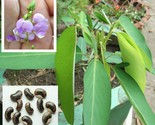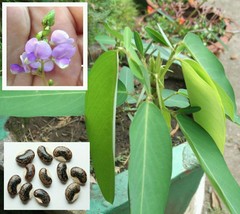Rendered at 01:31:17 08/19/25
Free Shipping
10 Telegraph Plant/Motor-Leaf Seeds ~ Codariocalyx motorius (Desmodium gyrans)
$27.25
Shipping options
Estimated to arrive by Mon, Aug 25th.
Details
FREE via Standard shipping (1 to 5 business days) to United States
Offer policy
OBO - Seller accepts offers on this item.
Details
Return policy
Full refund available within 30 days
Details
Purchase protection
Catalog info
Payment options
PayPal accepted
PayPal Credit accepted
Venmo accepted
PayPal, MasterCard, Visa, Discover, and American Express accepted
Maestro accepted
Amazon Pay accepted
Nuvei accepted
Shipping options
Estimated to arrive by Mon, Aug 25th.
Details
FREE via Standard shipping (1 to 5 business days) to United States
Offer policy
OBO - Seller accepts offers on this item.
Details
Return policy
Full refund available within 30 days
Details
Purchase protection
Catalog info
Payment options
PayPal accepted
PayPal Credit accepted
Venmo accepted
PayPal, MasterCard, Visa, Discover, and American Express accepted
Maestro accepted
Amazon Pay accepted
Nuvei accepted
Item traits
| Category: | |
|---|---|
| Quantity Available: |
10 in stock |
| Condition: |
Unspecified by seller, may be new. |
| Form: |
Seeds |
| Common Name: |
Telegraph Plant. Dance Weed. |
| Genus: |
Codariocalyx |
Listing details
| Seller policies: | |
|---|---|
| Shipping discount: |
Seller pays shipping for this item. |
| Price discount: |
18% off w/ $20.00 spent |
| Posted for sale: |
More than a week ago |
| Item number: |
694695870 |
Item description
Telegraph Plant, Dancing Grass or Dance Weed (Codariocalyx motorius alt. Desmodium gyrans) is one of the few plants capable of relatively rapid movement.
Flowers are purple, leaves are trifoliate with the center leaflet much larger than the side ones. As the hypothesis goes, moving leaves takes a lot of energy so these smaller leaves move independently of the large leaf, essentially sampling the sun for the right reading and then moving the larger leaves in place for optimal absorption of sunlight. (Another hypothesis exists that the movement deters predators).
Charles Darwin Described this plant in detail in his 1880 The Power of Movement in Plants. In colder regions it is deciduous and goes through a dormancy, grows year round in warmer climates. Grows to a height of around a four feet, give or take a bit.
Important to note that touching the plant does not make it move like Mimosa pudica (sensitive plant). One of the REALLY cool things about this plant is that sound may make it move. That's right. Sound. Particularly high pitch (high frequency) sound waves. They move fast enough for the human eye to see ...though time lapse highlights the movement better. The more they are exposed to sounds the more improved their "dancing", which leads to some speculation that they have a kind of memory. Either way, fun stuff to ponder.
Propagation: Scrape seed slightly with sharp knife or on rough stone surface to break watertight seed coat. Soak seeds for 12 to 18 hours in warm water until plump. Plant the seeds at a depth of 1/2 inch (1 cm). Ideal germination temperatures are 75F to 80F (24C to 27C). Germination usually takes 10 days to three weeks.
For faster germination, carefully remove seed coat from seed after soaking for 18 hours, making sure to leave root tip intact. Plant in sterile seed starting mix by placing seed, root tip side down, in 1/4 inch deep slit in seed starting mix. Keep soil moist, but not water logged. Place in well lit area. You should notice some growth within the week.
Like to dry out well between watering. Can be in full sun if grown in clay...part shade to full shade if in a sandy or loamy mix. Prefers a fairly neutral pH between 6-7.5.
Movement in Telegraph Plant is caused by swelling and shrinking of motor cells in pulvini at the base of the leaflets (same concept as Mimosa pudica). Ion and water movements cause these changes across the cell membranes of the motor cells.
Added to your wish list!

- 10 Telegraph Plant/Motor-Leaf Seeds ~ Codariocalyx motorius (Desmodium gyrans)
- 10 in stock
- Price negotiable
- Handling time 1 day. Estimated delivery: Mon, Aug 25th
- Returns/refunds accepted
Get an item reminder
We'll email you a link to your item now and follow up with a single reminder (if you'd like one). That's it! No spam, no hassle.
Already have an account?
Log in and add this item to your wish list.










